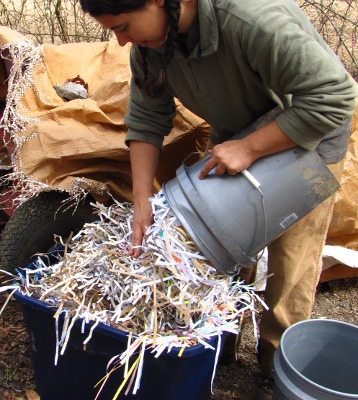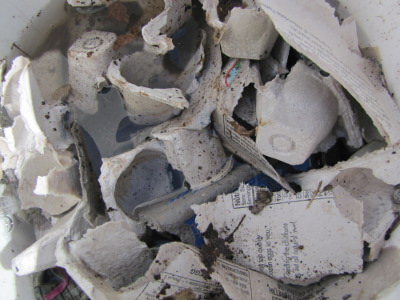
Worm bin bedding
 Worm composting is a lot like
ordinary composting in that it's important to mix together the right
ratio of browns (high carbon materials) and greens (high nitrogen
materials) for efficient composting without a bad smell. In the
past, greens have been in short supply on our farm, but now that we're
getting food scraps from a local school, we're suddenly short of
browns. The browns make up the bedding in the worm bin, covering
up the food scraps so that they don't smell and keeping the bin damp
and aerated, so we really can't skimp there. Time to do a bit of
research and figure out which waste materials can be used as bedding in
a worm
bin:
Worm composting is a lot like
ordinary composting in that it's important to mix together the right
ratio of browns (high carbon materials) and greens (high nitrogen
materials) for efficient composting without a bad smell. In the
past, greens have been in short supply on our farm, but now that we're
getting food scraps from a local school, we're suddenly short of
browns. The browns make up the bedding in the worm bin, covering
up the food scraps so that they don't smell and keeping the bin damp
and aerated, so we really can't skimp there. Time to do a bit of
research and figure out which waste materials can be used as bedding in
a worm
bin:
- Shredded paper seems to
be one of the best options, as long as you steer clear of glossy
magazines and seed catalogs. Once separated into small strips in
a shredder,
paper soaks up water well, and the spaghetti-like strands tend to stay
fluffy, allowing lots of air to get to the worms. We had planned
to focus on shredded paper for our worms' browns, but quickly ran
through our junk mail and needed much more!
- Cardboard is another good option, although you have to tear corrugated cardboard by hand. (The thin cardboard that many foods come in goes through our shredder.) Several people have reported good luck using cardboard in their worm bins, but it's essential to keep an eye on it and make sure the cardboard doesn't mat down and make the bin anaerobic.
- Autumn leaves don't require any work to prepare them for use in the bin, but can tend to mat down. Also, they don't absorb as much water as other bedding materials, so you risk having your worm bin dry out. It sounds like leaves make a good bedding when mixed with other high carbon materials, but probably aren't the best idea by themselves.
- Cardboard egg cartons were suggested to me by J and I think they have a lot of potential. They're easy to rip apart, and I suspect that the complicated shape will make them much less likely to mat down than traditional cardboard.
- I've read about people using other materials for worm bedding
like straw, coconut coir, and peat moss, but those would all have to
come from the store for me, so they fail the "waste materials" test.
 Since I was itching to put
the first round of food scraps in our bin, I went ahead and gave all of
the free options above a try. I (mostly) segregated the bedding
into zones within the bin, so I should be able to tell which ones work
best for us when I come back through in a few weeks to check on the
state of decomposition.
Since I was itching to put
the first round of food scraps in our bin, I went ahead and gave all of
the free options above a try. I (mostly) segregated the bedding
into zones within the bin, so I should be able to tell which ones work
best for us when I come back through in a few weeks to check on the
state of decomposition.
| This post is part of our Hands-on Wormkeeping lunchtime series.
Read all of the entries: |
Want more in-depth information? Browse through our books.
Or explore more posts by date or by subject.
About us: Anna Hess and Mark Hamilton spent over a decade living self-sufficiently in the mountains of Virginia before moving north to start over from scratch in the foothills of Ohio. They've experimented with permaculture, no-till gardening, trailersteading, home-based microbusinesses and much more, writing about their adventures in both blogs and books.
Want to be notified when new comments are posted on this page? Click on the RSS button after you add a comment to subscribe to the comment feed, or simply check the box beside "email replies to me" while writing your comment.

Lisa --- Nothing like that near the school, but it might be worth looking into a place for our biweekly big city trips. We could definitely load up enough for a month at a time in the truck or minivan if we found a place with that much paper.
Sara --- My understanding is that glossy ink is the real problem, and that colored, nonglossy ink is okay in moderation. The cardboard egg cartons I've run into don't tend to have much colored ink, if any, but I'm sure some brands are different.
I found regular white office paper balls up into hard lumps that require quite a bit of time to break up. To prevent this, I was told to mix it into the existing bedding/food but then you're disturbing the worms, which impacts the rate of reproduction. Newspaper is easier to shred and doesn't clunk up as hard as white paper. I was able to source on newspaper here that uses vegetable ink, and knowing this, I can safely use it all the time. A second downfall to the office paper is that it can be printed on a variety of printers, with a variety of inks. Point of the story -- would it be worth the time to find one or two newspapers in your area that print with vegetable inks, and then strategize how to get a regular supply of that?
As for any heavy or corrugated paper, in your sewing kit do you have a pounce wheel or a rotary cutter? Make slivers out of the paper with not a lot of energy expended. Cut either with or against the seams. The pounce wheel will perforate it, making it easy to tear and the rotary cutter will, well, cut it. Be well worth trying don't you think?
J --- Does the office paper lump up even when it's shredded? I can definitely see how newspaper would be better --- the thin paper would give a lot more surface area for microorganisms to decompose it quickly. I think you're probably right that if I'm going to hunt down paper in bulk, I should focus on newspapers. Now I just need to figure out where to find that! I was thinking of maybe asking at the library to see what they do with their newspapers when they get old. The library is so small that I can't imagine them storing all those bundles of paper.
Vester --- My sewing kit has needles, thread, pins, and scissors in it --- I never got very high-tech. I might have to try a pounce wheel or rotary cutter if I find someone who has a set.
I might have to try a pounce wheel or rotary cutter if I find someone who has a set.